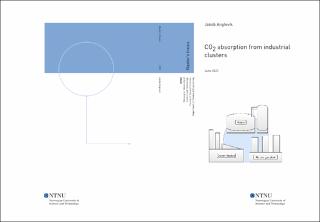| dc.contributor.advisor | Knuutila, Hanna | |
| dc.contributor.advisor | Nakao, Andressa | |
| dc.contributor.author | Anglevik, Jakob | |
| dc.date.accessioned | 2022-09-21T17:20:10Z | |
| dc.date.available | 2022-09-21T17:20:10Z | |
| dc.date.issued | 2022 | |
| dc.identifier | no.ntnu:inspera:111295783:64478710 | |
| dc.identifier.uri | https://hdl.handle.net/11250/3020500 | |
| dc.description.abstract | Denne oppgaven har brukt Aspen plus til å simulere forskjellige konfigurasjoner for CO2 fangst, for å finne den mest effektive måten å fange CO2 fra flere utslippskilder ved å bruke aminabsorpsjon. Dette er gjort ved å undersøke 3 forskjellige CO2-klynge konfigurasjoner for fangst av CO2 fra et naturgasskraftverk, et sementanlegg og et biogassanlegg i ulike skalaer. I den første konfigurasjonen er hvert anlegg er utstyrt med en egen absorber og en stripper. Totalt 3 absorbere, 3 strippere for 3 anlegg. Den andre konfigurasjonen bruker 3 absorbere og 1 stripper, kalt 3-1 klyngen. I dette scenariet skal aminløsningen fra hver absorber pumpes til stripperen for å bli regenerert og pumpes tilbake til absorberen. Den tredje konfigurasjonen ville se på å bruke 1 absorber og 1 stripper, kalt 1-1 klynge. Røykgassen fra de nærliggende anleggene skulle pumpes til denne sentrale absorberen og stripperen.
For å kvantifisere kostnadene for de forskjellige fangstkonfigurasjonene, er aminabsorpsjon blitt simulert i Aspen plus. Disse dataene har blitt brukt til å beregne kapitalkostnaden, driftskostnaden for hvert anlegg og prisen for alle de forskjellige pumpealternativene.
Funnene av dette arbeidet er at betydelige besparelser kan gjøres ved å bruke 3-1 klyngekonfigurasjoner. Et eksempel viser at for et biogass-, sement- og naturgassanlegg i stor industriskala kan kapitalkostnaden reduseres fra 610 til 532 $ MM, og driftskostnaden for fangstanleggene kan senkes fra 96 til 85 $ MM. For 1-1 klyngen er det potensielle besparinger, men disse faller fort bort ved en lang distanse mellom utslippskilden og absorberen. | |
| dc.description.abstract | This thesis has used Aspen plus to simulate different capture cluster configurations to find the most efficient way to capture CO2 from multiple emission sources using amine absorption. This has been done by examining 3 different CO2 cluster configurations for capturing CO2 from a natural gas power plant, a cement plant, and a biogas plant at different scales. The first configuration is represented as the base case, where each plant is equipped with an absorber and a stripper. Totaling 3 absorbers, 3 strippers for 3 plants. The second configuration uses 3 absorbers and 1 stripper, called the 3-1 cluster. In this scenario the solvent from each absorber is to be pumped to the stripper to be regenerated and pumped back to the absorber. The third configuration would look at using 1 absorber and stripper, called 1-1 cluster. The flue gas from the nearby plants would be pumped to this central absorber and stripper.
To quantify the cost of the different capture configurations, amine absorption has been simulated in Aspen plus. This data has been used to calculate the capital cost, running cost of each facility, and the price for all the different pumping options.
The findings of this work are that significant savings can be made by using the 3-1 cluster configurations. An example case shows that for a large industry scale biogas, cement and natural gas plant the capital cost can be lowered from 610 to 532 $ MM, and the running cost for the capture facilities can be lowered from 96 to 85 $ MM. for the 1-1 cluster there are potential savings, but these drop off quickly with increasing distance between the plants. | |
| dc.language | eng | |
| dc.publisher | NTNU | |
| dc.title | CO2 absorption from industrial clusters | |
| dc.type | Master thesis | |
